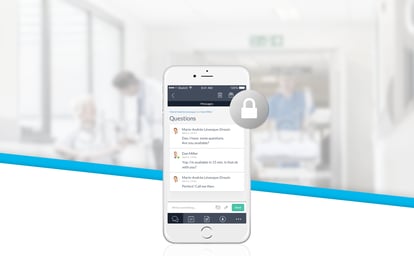
Are You Texting Private Patient Information?
With the emergence of new communication platforms, it can be difficult to know for certain which channels are secure and which ones aren’t. Emails are secure right? Wrong.
The “Health Care Blog” outlines that there are many more elements, to following local laws and regulations, than meets the eye. While some lead to expensive lawsuits, some are downright illegal. The deciding line can be ambiguous, and that’s definitely scary.
Either way, how does one know? Some communication platforms guarantee privacy, but are not secure and vice versa. These are two separate things! The lack of industry knowledge as to what secure and private communication actually is also presents a threat.
Why is Secure Communication Important?
In today’s digital world, physicians and hospitals are scrambling to privatize their in-house communications. From texting to sharing documents, everything must follow local laws and regulations.
If there is one thing that is certain, technology has not only facilitated our lives, but has also made it public to a certain degree. This is especially worrying when private information is being shared. If communication mediums are not monitored, patient information can easily be leaked or hacked and lead to a lawsuit.
In their presentation of healthcare communications, the Joint Commission outlined how miscommunications often lead to medical errors: “The majority of avoidable adverse events are due to the lack of effective communication.” Clearly, making sure the messaging platform is secure is step one.
This being said, are you 100% sure your messaging platform is securely private?
But, What Exactly IS Secure Messaging?
Communication is crucial when a patient’s life is on the line. Protecting that patient’s privacy, is also important. This is why many physicians are increasingly looking into secure healthcare messaging applications. However, simply stating that a messaging app is secure does not make it legally secure or private.
NON-secure communications:
- Dropbox for sharing documents;
- Emails that are not encrypted;
- Regular text messages;
- Messaging applications that do not specify being private and secure;
- Using cloud providers (Yahoo, Google, Amazon, etc);
- Websites that start with “http://” and not “https://” (“s” is for secure).
According to the CMPA’s (Canadian Medical Protective Association) “Using electronic communications, protecting privacy” article, there are three ways in which physicians can communicate with one another; mail and texting, social media platforms and web portals. Each has their own level of risk and the information shared within each should be considered in terms of their limitations.
With this in mind, coupled with the increase in physician online presence, there are many factors to consider when communicating on the job. Hospitals and physicians play an important role in ensuring the safekeeping of private patient information.
Who is Responsible for Ensuring Secure Messaging, Hospitals or Physicians?
Doctors often need to consult one another and they can’t simply pick up their phones and send a regular text message; not when it contains patient health information. So who is responsible for establishing secure messaging? Hospitals or physicians?
The answer is both. Hospitals should ensure secure messaging among its medical staff to increase communication efficiency and privacy. As was pointed out by the chief of staff at the Quebec Heart and Lung Institute,
“How can we expect our staff not to text one another if we do not present them with a secure option ourselves?”
– Dr. François Aumond
On the other hand, physicians should also make sure they are communicating in a manner that follows local laws and regulations at all times.
The Problems Behind Healthcare Communications
Although there are many, the main difficulty lies in the options available. Doctors needing to communicate securely often do not have the leverage to do so individually as most companies cater to hospitals as a whole.
The bigger problem? Money. Secure messaging applications often come at a price. A very high price. So who foots the bill? We have the solution to it all.
The Solution to Physician Secure Messaging

PetalMD offers a web-based scheduling platform that includes secure messaging. This is available for groups and individuals and can even be tailored to integrate within hospitals already using existing technologies. Did I mention that it’s free? Well, it’s FREE.
Our secure messaging extends beyond specialty groups. Physicians have access to the growing network of more than 25,000 Canadian physicians already on our platform. We made it our mission to connect healthcare networks.
To show the advantage of such a network: say you are working on a case and need to consult an expert in another province. Through typical channels, it would take days to send documents and communicate privately. With PetalMD, it takes seconds. With our secure web-based network, you can send and receive documents privately and instantly.
Are you a physician or hospital employee wondering if your communication is secure?
